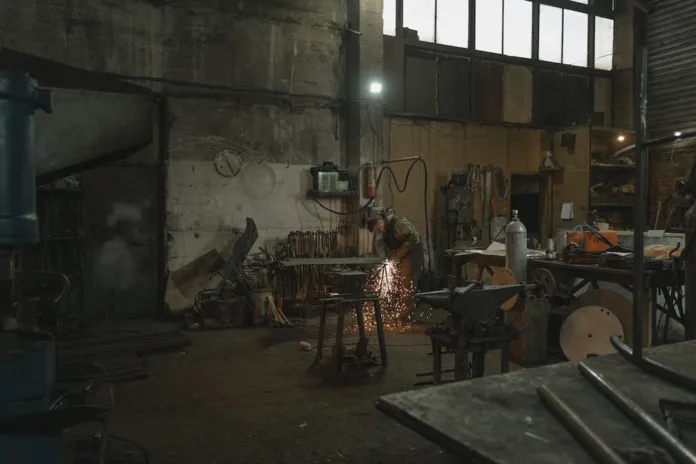All of us probably have a good idea of the role welding plays in construction. You know welding, the fusing of two metals with a hot torch.
We’ve all seen it or bore witness to its characteristic light show. The sparks emitted by the welding arc have their own name, welders call it spatter. If not anything else, we’ve all seen the spatter.
But welding is much more than the white-hot spatters, of course. It is quite literally the process of building the building blocks of the incredible and magnificent constructions around us.
That’s why we’re bringing a special focus on welding and four facts about welding in the construction industry. Get ready with your hot-torches, because we are about to learn all about welding!
1. Welding’s Diverse Use
Welding is used in numerous facets and aspects of construction, ranging from the creation of the structural components themselves, such as the beams and columns, to the assembly of bridges, buildings, and other major infrastructure buildings.
Welding is also used to repair heavy equipment and machinery used in the industry. What welders used to weld also comes from welding, so it’s safe to say welding is the atom of construction, in terms of how important and indispensable it is to the industry.
2. Welding Processes
There are several commonly used welding processes used in construction based on the specific requirements of the project. Let’s take a look at some key welding processes,
Arc Welding
This welding process uses electricity to create an electric arc between an electrode and the base metal, melting both and forming a weld.
Welders apply positive voltage to the electrode and negative voltage to the base material. This causes the arc to travel from the base to the electrode.
Stud Welding
This is another special welding technique commonly used in construction and manufacturing industries. Welders secure a metal stud, often made from steel, into an object by creating a high-intensity electrical arc.
The arc melts the base of the stud and the object and forms a strong and durable weld. This is widely used for attaching for industrial fastening, brackets, and other components to metal surfaces, offering an efficient solution for joining metal elements in various construction projects.
So, after you receive one from an industrial fastening supplier, welding might be used to fasten it tightly.
Metal Inert Gas (MIG) Welding
This method uses a wire electrode and a shielding gas to create a clean, efficient weld. As the wire melts, it creates a weld pool that fuses the materials together.
MIG welding is widely used for its efficiency, speed, and ease of use, and is preferred by welders in construction, automotive, and manufacturing.
Tungsten Inert Gas (TIG) Welding
This process uses a non-consumable tungsten electrode, it creates a high-temperature arc to fuse metals together. What really sets TIG welding apart is the use of a shielding gas, usually argon, to protect the weld area from atmospheric contaminants.
This method produces clean and intricate welds, making it effective for thin materials and uses, calling for incredible precision.
TIG welding is used in aerospace, automotive, and artistry, giving welders exact control and delivering high-quality results. The only gripe with TIG welding is that it takes a little more time than other welding methods.
Plasma Arc Welding
This is a more advanced type of welding that uses a constricted arc to join metals. In this process, an inert gas is ionized to form a plasma arc, which reaches extremely high temperatures, giving precise and efficient welding.
Plasma arc is faster, gives more control to the welders, and the versatility in terms of using it on a lot of other metals. PAW is commonly used in the aerospace and automotive industries.
3. Structuctural Integrity and Safety
Welding is critical for making sure the structural integrity and safety of constructed buildings and infrastructure. Welded joints must be of high quality and substantially strong to withstand the stresses, pressure, and loads placed on them over time.
Proper weld inspections and following industry standards are essential to guarantee the safety and durability of finished structures and projects.
If the Brooklyn Bridge or Sydney Harbour Bridge were built from poorly welded components, they would’ve been history by now.
4. Welding Certification and Skilled Workforce
Skilled welders are essential for successful construction projects. Many construction welding jobs need certification to make sure welders meet industry standards. Welding certifications are often specific to certain welding processes and materials.
Properly certified welders bring expertise in various welding processes, like the one we discussed, arc welding, MIG welding, and TIG welding.
A skilled workforce with experienced and competent welders will inevitably contribute to the overall quality and safety of construction projects.
So, if you’ve got any construction projects coming up, make sure you’ve got certified and experienced welders to do the job, properly and expertly.
Things To Remember About Welding
When it comes to welding, you need to keep in mind a few key considerations about this widely used process.
- Safety is Paramount: Safety is key, so it is important to wear appropriate protective gear, including helmets, gloves, and safety glasses.
- Know Your Materials: Different metals need specific welding techniques, temperatures, and filler materials. Knowing your materials guarantees strong and durable welds.
- Proper Equipment Matters: Welding equipment must be set up and adjusted properly. Factors like voltage, current, and wire speed must be prioritized by welders in construction projects, minor or major.
- Quality Control and Inspection: Regularly inspect and assess the quality of your welds. This includes checking for weld penetration, uniformity, and no defects.
- Choose The Right Welding Process: Choose the right processes, whether it’s arc welding, MIG, or TIG welding, that align with what the project requires.
Conclusion
There you have it! We hope you enjoyed this intricate take on four facts about welding in the construction industry. Welding is vital, and there are newer and improved welding techniques to elevate the construction industry.


